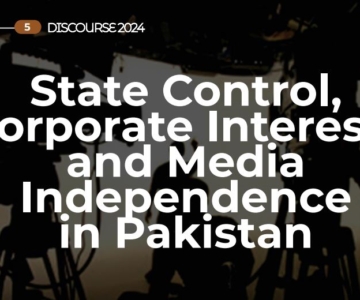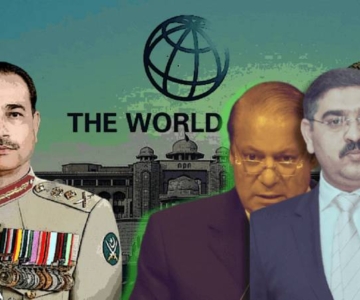Much has been elaborated on the binding constraints faced by Pakistani democracy. Conventional wisdom suggests that the civil-military imbalance has left little space for democratic institutions to grow and flourish. There can hardly be any disagreement with this point of view. In fact, decades of centralised martial rule have resulted in the militarisation of the society to such an extent that one can hardly discuss anything pertaining to Pakistan without a mention of the Pakistan Army and its role in the country.
There is also a predominant counter narrative in the mainstream discourse. This view holds the impatient and elitist Pakistani politicians responsible for the systemic crash each decade. It stresses that the politicians are adept at undermining the democratic order and it is because of their petty differences and thirst for power that they enter into alliances with the powerful establishment.
The year 2010 is no different as these competing narratives are yet again haunting us. The major breakthrough that was ostensibly achieved with the signing of the Charter of Democracy (CoD) appears to have been diluted at best. In fact, all signs suggest that the mistrust and acrimony of the earlier eras is gradually returning thereby paving the way for another systemic breakdown.
The civilian space reclaimed by the political parties in the year 2008, backed by political mobilisation in that same year was heralded as a new beginning. The elections of 2008 returned the banned parties and their leadership into the legislature, thus defeating a decade of political engineering by general Musharraf and his political and non-political cronies. What happened in the following two years is a question that needs to be addressed.
Shortly after the formation of the civilian governments, the judges’ issue became a major bone of contention between the Pakistan People’s Party (PPP) and its ally Pakistan Muslim League-Nawaz (PML-N). From the very beginning, the issue of the dismissed judges had been politicised beyond reasonable limits, and PPP’s somersault on the issue led to the dissolution of an accord that had been reached after years of struggle. Ultimately, it was the threat of street power as well as the intervention of the Army Chief and high powered US officials that led to the restoration of the judges. This new found populism by a historically pliant Supreme Court became a new factor in Pakistani politics.
Thereafter, the intersection of judicial decisions and politicking became muddled, thanks to an overgrown but untrained media that saw signs of a government dismissal in every verdict announced by the Honourable courts. We also saw that late night meetings of the opposition politicians with the Army Chief took place in full view of a sensational media. Thus, a trite and beaten storyline emerged in the discourse.
The ruling PPP at the Centre, unfortunately, did not set a good example of governance either. Its team of advisors was neither competent nor adept at facing the national crises. Thus, an image of incompetence compounded by corruption scandals of yore became the excuse to derail the democratic system. This is the irony of our country: when thinkers and opinion makers, despite the disasters of authoritarianism, start asking the army to intervene. A good number of media commentators have now taken this line of warning all and sundry that GHQ will not sit quietly in the face of political deadlock while the country ‘burns’. Haven’t we heard this so many times in the past?
The skirmishes in the Sindh Assembly between the PPP and the MQM, and the hot words and accusations in the National Assembly are all too familiar. The people of Pakistan are aware that this is how the political elites tend to behave and, in so doing, squander the opportunities to build and strengthen institutions.
However, there is another side to this story which is less talked about and underreported for obvious reasons. The truth is that the current civilian rule in the centre is now merely pomp and show signifying quite little. The policy initiatives are not being taken by the elected institutions but are stemming from elsewhere, that is, the unelected institutions of the state.
First, the foreign policy and what is so fondly known here as the national security issue needs to be discussed. President Zardari made some bold remarks on Indo-Pakistan relations in the year 2008. A few weeks down the road a militant outfit allegedly caused rumpus in India’s commercial nerve centre, Mumbai. Since that fateful November day, the relations have only been tense or outright acrimonious. The war on terror is more of a US-Pak Army relationship and whatever little input there was from the civilian authorities is all history. The US generals and officials pay courtesy visits to the Presidency and the Prime Minister’s House while policy and operational decision-making is handled by others.
Second, the bankrupt Pakistan of 2008 had to accept the tough conditions of IMF for a stabilisation phase. This government, like all governments of the past, cannot think of changing the structure of public expenditure. There is a war on terror and the army is engaged on several fronts. Therefore, a reduction in defence budget is out of the question. On the other hand, it cannot initiate administrative reforms either as the sharper and more experienced bureaucrats manage the ministries while the inept politicians only focus on short-term patronage for their constituencies. This is a neat division but the result is more of the status quo. Even the Prime Minister’s effort to make high level appointments and promotions is not subject to judicial review. What can a weak civilian government do in this climate other than think of surviving in office?
Third, the Army and the Judiciary have a complete autonomy over the appointments, extensions and personnel policy. This is not the case in India and other countries in the region. The recent crisis over the appointment of judges to the Superior Courts was a testament to this reality. Exercise of elected executive power resulted in a national crisis and ultimately the central government had to surrender. As far as the Army appointments are concerned, we do not even know since such discussions and parleys are conducted behind closed doors, once again, for reasons of national security.
Finally, the ascendancy of media and all-powerful TV anchors further limits the arena for executive action. What can be done when the accountability mechanism of a government happens to be ill-informed debates by non-specialists on TV and in print? This is not to say that media freedoms are not important. They are vital for a democracy but they cannot undermine a democratic disorder while being in a hyperactive mode.
Thus encircled by a powerful troika of three unelected institutions, the democratic government’s fate should be obvious. It is sadly not all too different from what was the case in 1988 or when a civilian Prime Minister tried to change an Army chief in 1999. The only difference is that the President who happens to be in office cannot be fired as easily as was the case in the past. The constitutional niceties and legal twists prevent a smooth dismissal. There is also a faint sign that the key opposition party does not want to rock the system as it knows that the consequences would not necessarily turn in its favour.
What shall we make of this mess? Are the politicians unable to govern or are they now allowed by the powers-that-be to govern? These questions are not simple as they are interlinked at some level and merge into the larger mess of Pakistan’s history.
The Constitutional amendments that are due to be announced by the end of March 2010 are the key to this dilemma and perhaps to the future of democracy in Pakistan. If the ruling political elites can actually agree on the contours of the revised governance arrangements then perhaps there is a chance for a political consensus to emerge. After all, the parties have reached a compromise on the issue of National Finance Commission Award. Following that pattern, the issue of amendments can also be sorted out. The PPP must recognise that its own survival, beyond the short term considerations of retaining a powerful Presidency, is predicated on the evolution of a political consensus and a constitutional framework that holds the elected Parliament at its apex.
Similarly, the PML-N should also acknowledge that if the powers of the President are not trimmed this time around, an all powerful Presidency could be a potential problem for its future government[s]. The regional parties also have the best solution to their long held grievances in a federal Constitution. Extra constitutional arrangements have not worked in the past and are unlikely to have any value in the future.
The central question is whether the political elites have learnt their lessons. The evidence is sketchy and unclear. There is substantial evidence to suggest that an unwritten consensus exists on letting the system work and allowing the elected governments to complete their tenure. On the other hand, there are terrible signs that many among the ranks of the politicians are not averse to a doctored change, either through the judicial diktat or through a street agitation. We can only hope that the latter is a fabrication of some twisted minds.
Pakistan’s survival and stability requires a democratic framework within which its various provinces have a voice and that a transition to democratic rule is achieved through a regular, robust and transparent electoral process. Other solutions are non-options. This is why 2010 is an important year. It might surprise the skeptics or actually please the usual suspects. We can only hope that it proves the anti-democratic forces wrong by letting the political parties agree on a common governance framework in line with the consensus 1973 Constitution.
A version of this article appeared in The News
Raza Rumi is a policy expert based in Lahore. He blogs at www.razarumi.com and edits Pak Tea House and Lahore Nama. Email: razarumi@gmail.com



